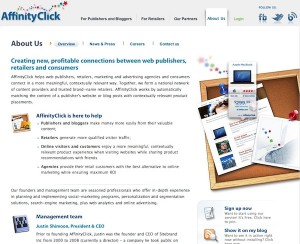Brand-new webcopy created by thinkit creative: AffinityClick, a powerful “click-magnet” for bloggers, is now live.
Four steps to a more reader-friendly website
![]() Whether you’re a large organization that’s keen on carving out new market share or a small-sized operation that’s looking to build a presence in the marketplace, your web copy plays a key role in reaching readers and turning them into clients (and for some, turning readers into investors). Building an online presence is never easy, but you can make far less work for yourself just by paying extra careful attention to how you present your business case in your online copy.
Whether you’re a large organization that’s keen on carving out new market share or a small-sized operation that’s looking to build a presence in the marketplace, your web copy plays a key role in reaching readers and turning them into clients (and for some, turning readers into investors). Building an online presence is never easy, but you can make far less work for yourself just by paying extra careful attention to how you present your business case in your online copy.
Here are four ways you can make your web copy more reader friendly, including handy exercises to make it all happen today.
1. Focus less on you and more on them—your reader. It’s often tempting to cram a site full of copy, detailing who you are and what you do. Don’t give in! Granted, your readers do need to understand what your business is all about, but never do so at the expense of demonstrating what’s in it for the reader to do business with you. Here’s a simple exercise that I do with my clients (and I even do this with my own copy). Print a copy of your website and circle each and every reference to “I” or “we” or “us.” See if you can cut back those references by about 25 percent. For each instance, ask yourself if there’s a way you can change your copy so that it refers less to you and more to the readers. The result will be copy that sells readers on the benefits of doing business with you, while still leaving room for you to tell your story.
2. Be useful. There’s broad appeal to being seen as a resource that saves time. Websites are no exception. One exercise that I like to do with clients is the “10 points” test. Looking at your existing site, find 10 things that a reader might come looking for when visiting. Award yourself a point for each item you find and then think of ways to improve your score. Being useful can be as simple as including an always-fresh list of links to favourite books. The key is to put yourself in the shoes of the reader.
3. Be easy to reach. This might seem obvious, but consider the bulk of websites out there and how they treat vital contact information, such as phone numbers, email and postal addresses. They bury them under some tab called “Contact us.” Don’t make your readers work hard to reach you. Even if you simply include a footer at the bottom of each page with just your main phone number, readers will appreciate the thought. And you’ll have just earned a point in the “10 points” test.
4. Be brief. Do you really need to plow every detail of your company’s purchasing process onto the main area of your website? Even for readers who love details (and yes, there are many out there), they’ll appreciate it if you keep your online copy brief and punchy. Use links to archived material or to PDF documents for cases where there’s important background material that needs to be in the public domain. Try limiting every page to no more than 150 words.
